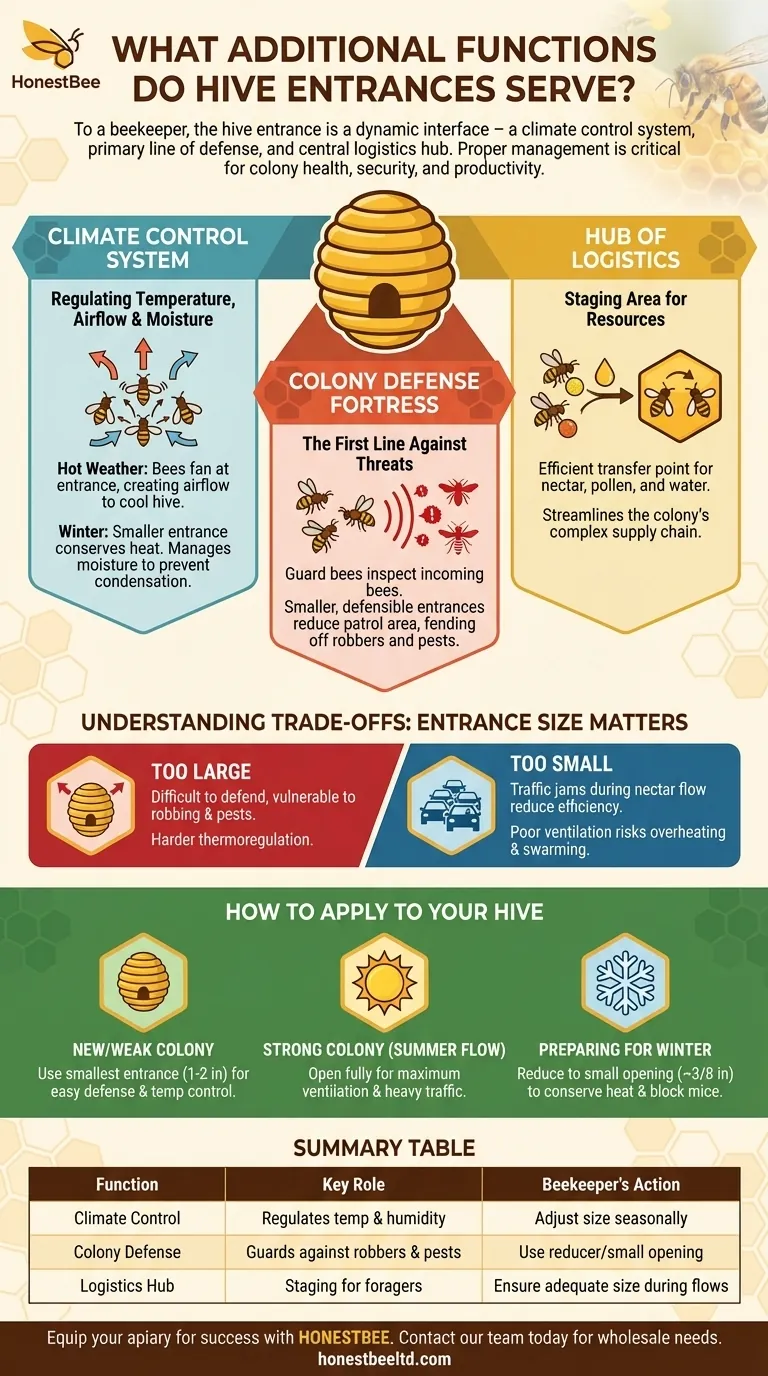To a beekeeper, the hive entrance is far more than a simple doorway for bees. It is a dynamic interface that serves as the colony's climate control system, its primary line of defense, and its central logistics hub for managing resources. The size and configuration of this entrance directly influence the colony's health, security, and productivity.
The hive entrance is not a passive opening but an active control point. Its proper management is one of the most critical levers a beekeeper has for regulating the colony's internal environment and defending it from external threats.

The Entrance as a Climate Control System
A honeybee colony must maintain a stable internal environment, particularly in the brood nest where temperatures are held around 95°F (35°C). The entrance is the primary tool for achieving this thermoregulation.
Regulating Temperature and Airflow
In hot weather, bees congregate at the entrance and fan their wings, creating a coordinated airflow. This ventilation system pulls hot, stale air out of the hive and draws cooler, fresh air in, preventing the delicate wax comb from melting and cooling the brood.
In winter, a smaller entrance reduces the amount of cold air entering the hive, making it easier for the colony's cluster to generate and conserve the heat necessary for survival.
Managing Internal Moisture
Bees and curing nectar produce a significant amount of water vapor. An appropriately sized entrance allows this moist air to escape, preventing condensation from forming inside the hive. This is critical in winter, as cold moisture dripping on the cluster can be fatal.
A Fortress Gate for Colony Defense
The entrance is the single point of entry that must be defended against a constant barrage of threats.
The First Line of Defense
Guard bees are stationed at the entrance, where they inspect every incoming bee for the correct colony odor. They are responsible for identifying and repelling intruders, providing a crucial barrier against threats.
Preventing Robbing and Pests
A smaller, more defensible entrance is vital for a colony’s security. It reduces the area that guard bees must patrol, making it easier to fend off robber bees from other hives, wasps, and other pests seeking to steal honey or harm the colony.
The Hub of Hive Logistics
The area immediately inside and outside the entrance acts as a busy staging ground for all colony resources.
A Staging Area for Resources
Foraging bees returning with nectar, pollen, or water often land at the entrance. Here, they transfer their resources to receiver bees, who then carry them to the appropriate storage cells within the hive. This transfer point streamlines the colony's complex supply chain.
Understanding the Trade-offs: Entrance Size Matters
The optimal entrance size is not static; it changes with the seasons and the strength of the colony. Mismanaging it can create significant problems.
The Problem with an Entrance That's Too Large
A large entrance, especially for a small or developing colony, is difficult to defend. This makes the hive highly vulnerable to being robbed out by stronger colonies and exposes it to pests. It also makes thermoregulation far more difficult.
The Problem with an Entrance That's Too Small
During a heavy nectar flow, a small entrance can create a "traffic jam" for foraging bees, reducing the colony's efficiency and potential honey harvest. Insufficient ventilation from a small entrance can also lead to overheating in the summer, which can increase the likelihood of the colony swarming.
How to Apply This to Your Hive
Managing the entrance size with a reducer or other tools is a fundamental beekeeping task. Your approach should adapt to the colony's specific situation.
- If your colony is new or weak: Use the smallest possible entrance (1-2 inches) to make defense easy and help them control the internal temperature.
- If you have a strong colony during a summer nectar flow: Open the entrance fully to maximize ventilation and accommodate heavy forager traffic.
- If you are preparing for winter: Reduce the entrance to a small opening (around 3/8 inch high) to conserve heat and prevent mice from entering.
Properly managing the hive entrance is a direct reflection of your understanding of the colony's needs.
Summary Table:
| Function | Key Role | Beekeeper's Action |
|---|---|---|
| Climate Control | Regulates temperature & humidity | Adjust size seasonally for ventilation or heat retention |
| Colony Defense | Guards against robbers & pests | Use a reducer for weak colonies; small opening for winter |
| Logistics Hub | Staging area for foragers & resources | Ensure adequate size during heavy nectar flows to prevent traffic jams |
Equip your apiary for success with HONESTBEE.
Proper hive management starts with the right equipment. As a trusted wholesale supplier to commercial apiaries and distributors, HONESTBEE provides the durable, high-quality beekeeping supplies you need to master entrance management and optimize colony health.
Let us help you build a more productive and secure operation. Contact our team today to discuss your wholesale needs and discover the HONESTBEE difference.
Visual Guide

Related Products
- Beehive Entrance Reducer Guardian Metal Hive Entrance for Bees
- Multi-Functional Sliding Hive Entrance for Beekeeping
- Professional Reversible Beehive Hive Entrance
- Multi-Functional Rotary Hive Entrance Disc for Beekeeping
- Beehive Entrance Discs Plastic Bee Entrance Disc for Bee Hives
People Also Ask
- How can a Langstroth hive entrance be adjusted? Mimic Natural Bee Preferences for a Healthier Hive
- What are the two functions of the Entrance Reducer? Master Hive Defense and Safe Transport
- How big should a beehive entrance be? Optimize for Colony Health & Honey Production
- What is the purpose of placing an object in front of the hive entrance after a move? A Guide to Forced Reorientation
- What are the different entrance sizes for an 8 or 10-frame Langstroth hive? A Guide to Seasonal Management



















